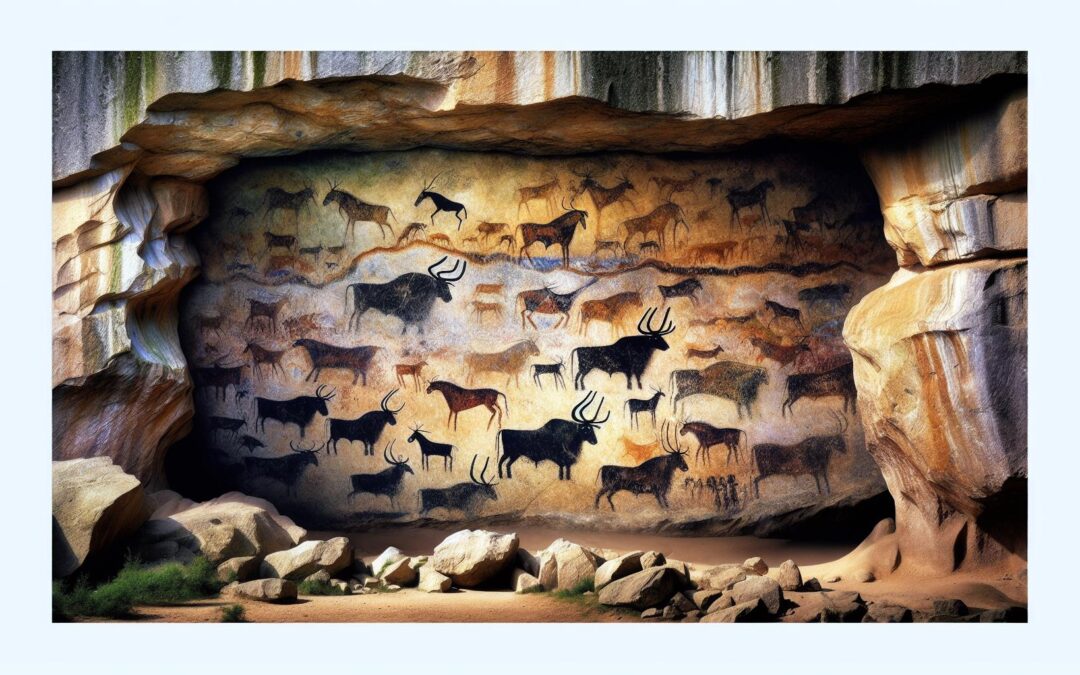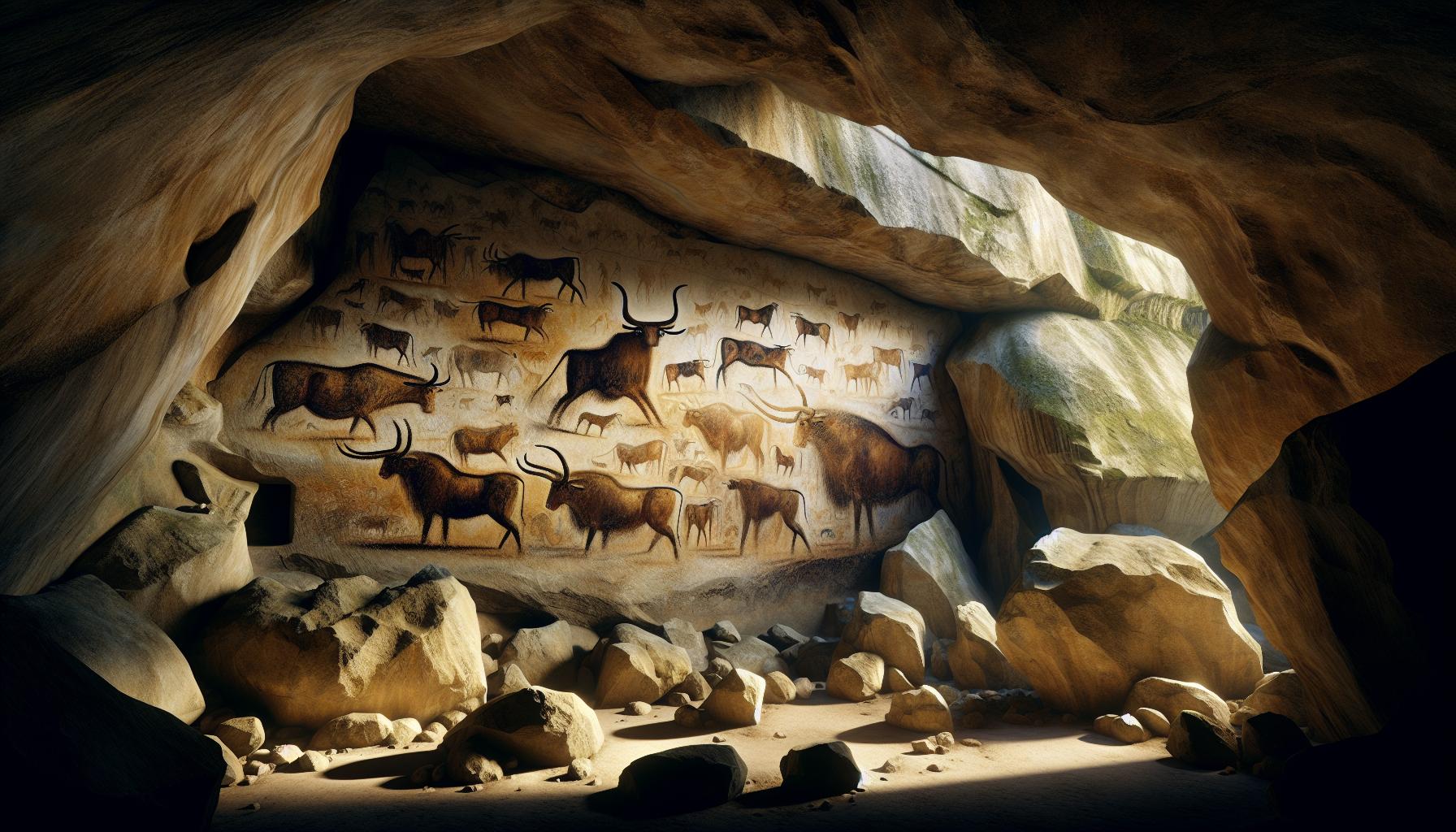Deep within the Lascaux Caves of southwestern France lies the Great Hall of the Bulls, a stunning testament to prehistoric artistry. Dating back over 17,000 years, this remarkable site showcases a breathtaking array of life-sized animal paintings that have captivated historians and art enthusiasts alike. The vivid depictions of bulls, horses, and other creatures offer a glimpse into the lives and beliefs of early humans. As students dive into AP Art History, the Great Hall of the Bulls serves as a pivotal example of the intersection between art, culture, and history. Understanding its significance not only enriches their appreciation for ancient art but also provides insight into the evolution of human expression. Exploring this iconic site reveals the profound connection between humanity and the natural world, making it an essential topic for any art history curriculum.
Great Hall of the Bulls AP Art History
The Great Hall of the Bulls, located in the Lascaux Caves, features approximately 600 painted animals, primarily focusing on bulls, horses, and deer. These vivid depictions highlight early human creativity and skill in using natural pigments. Dating back over 17,000 years, these paintings represent one of the most significant achievements in prehistoric art.
Artists employed techniques such as silhouette painting and variations in color to enhance the dynamism of the images. The large size of the animals contributes to their majestic presence, emphasizing their importance in the daily lives of the people who created them. These artworks likely served various purposes, including ritualistic, symbolic, or educational functions.
The Hall’s layout showcases clusters of animals, presenting a narrative that captures the complex relationship between humans and their environment. Each section reflects the artists’ knowledge of animal behavior, suggesting a deep understanding of their habits. The Great Hall of the Bulls stands as a testament to the cultural and spiritual values of early societies, making it an essential study area within AP Art History.
Historical Context
The Great Hall of the Bulls holds significant value in understanding early human culture and artistic expression. Its origins and discovery contribute to its importance in the study of prehistoric art.
The Paleolithic Era
The Great Hall of the Bulls dates back to the Upper Paleolithic era, spanning from approximately 40,000 to 10,000 BCE. This period marks the height of human creative development, with hunter-gatherer communities expressing their experiences through art. Predominantly, the depicted animals—such as bulls, horses, and deer—reflect the species crucial for survival, demonstrating the artists’ intimate understanding of their environment. Ritualistic elements likely intertwined with these artworks, revealing the spiritual beliefs and social structures that influenced prehistoric life.
Discovery of the Cave
The Lascaux Caves, home to the Great Hall of the Bulls, were discovered in 1940 by four teenagers exploring the area. Their inadvertent find led to extensive investigations, uncovering over 600 wall paintings. Archaeologists quickly recognized the site’s significance, noting both the artistry and the preservation of these vivid works. The discovery heightened interest in prehistoric art, igniting debate among historians and archaeologists regarding the symbolism and meaning behind these depictions. Protection efforts soon followed, as exposure to carbon dioxide from visitors threatened the cave’s integrity.
Artistic Techniques Used
The Great Hall of the Bulls demonstrates a range of artistic techniques that highlight the creativity and skills of its prehistoric creators. Two primary areas of focus include tools and materials as well as styles and methods.
Tools and Materials
Artists utilized natural materials available in their environment. They crafted pigments from earthy minerals like ochre, charcoal, and hematite. These pigments produced vibrant reds, blacks, and browns. For application, they used rudimentary tools such as sticks and their hands, enabling them to create both finely detailed and broad brush-like strokes. The use of animal fat likely served as a binder, allowing pigments to adhere to the cave walls effectively. This combination of materials and techniques showcases the resourcefulness of early humans in producing lasting artworks.
Styles and Methods
The artworks exhibit distinctive styles marked by dynamic compositions and movement. Artists employed silhouette painting, focusing on the outlines of animals without internal detailing. This method emphasizes form and size, enhancing the visual impact. They also incorporated shading techniques to create depth and texture, using color variations to differentiate species. The placement of figures in relation to one another forms a narrative, illustrating actions and interactions, suggesting a sophisticated understanding of animal behavior. These artistic choices reflect not only aesthetic preferences but also the cultural significance of the animals depicted.
Symbolism and Interpretation
The Great Hall of the Bulls encapsulates profound symbolism and interpretation that reveal insights into early human cognition and spirituality. The representations of animals suggest complex cultural narratives, influencing ongoing studies in art history.
Cultural Significance
Cultural significance permeates the artwork in the Great Hall of the Bulls. The representation of animals, particularly bulls, highlights the importance of these creatures in the daily lives and survival of Upper Paleolithic societies. The imagery likely served not only as a reflection of the natural world but also as a means of communication within those communities. Such depictions could signify successful hunts, symbolize fertility and continuity, or even serve as an invocation for spiritual support. The cave’s artworks may have functioned as teaching tools for younger generations, imparting crucial survival knowledge and cultural traditions.
Theories of Meaning
Theories of meaning surrounding the Great Hall of the Bulls present various interpretations that enhance understanding of prehistoric art. Some researchers argue that the paintings reflect shamanistic practices, where animals symbolize spiritual guides. Others posit that the arrangements of animals portray dominance hierarchies or social structures within the community. Recent studies suggest that the placement of animals may encode hunting strategies or environmental observations, revealing the artists’ acute awareness of their surroundings. Each interpretation adds a layer to understanding the symbolic frameworks underpinning this ancient art form, emphasizing the multifaceted relationship between humanity and nature during that era.
The Great Hall of the Bulls Today
The Great Hall of the Bulls remains an iconic representation of prehistoric art, attracting researchers and visitors alike. Its preservation, education, and cultural significance continue to evolve in modern contexts.
Preservation Efforts
Preservation efforts for the Great Hall of the Bulls focus on maintaining the integrity of the cave paintings while accommodating scholarly research and public interest. Various protective measures include controlled access, which limits the number of visitors to reduce environmental impact. Technological advancements, such as digital scanning, help document the artwork while minimizing physical interaction with the original site. Conservation programs monitor humidity and temperature levels to prevent deterioration, ensuring the iconic imagery remains intact for future generations. Additionally, collaboration between governments and heritage organizations raises awareness and resources for these preservation initiatives.
Educational Impact
The Great Hall of the Bulls serves as a vital educational resource in art history and anthropology. Academic programs incorporate the site into curricula, providing students with firsthand experience of prehistoric culture. Online databases and virtual tours increase accessibility, allowing global audiences to explore the artwork and its historical context. Museums and educational institutions host exhibitions and workshops, emphasizing the significance of the cave’s art in understanding human development and creativity. The legacy of the Great Hall of the Bulls continues to inspire research, illustrating the intersection of art, history, and cultural identity. The Great Hall of the Bulls stands as a remarkable testament to early human creativity and cultural expression. Its intricate animal depictions not only reveal the artists’ profound understanding of their environment but also highlight the spiritual and ritualistic significance of these works. As a vital area of study in AP Art History, it continues to captivate scholars and enthusiasts alike. Preservation efforts ensure that future generations can appreciate this extraordinary glimpse into prehistoric life. The ongoing exploration of its symbolism and techniques enriches our understanding of humanity’s artistic journey. The Great Hall remains an essential link between the past and present, illustrating the enduring connection between art, culture, and identity.


